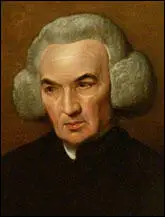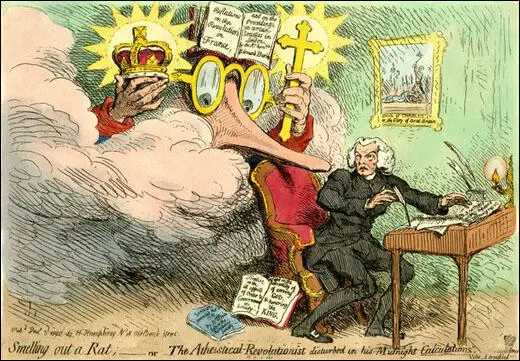Richard Price

Richard Price, the son of Rice Price, a Congregational minister, was born in Tynton, Glamorgan in 1723. From an early age he appears to have rejected his father's religious opinions and instead was attracted to the views of more liberal theologians.
Price attended a Dissenting Academy in London and afterwards became a chaplain in Stoke Newington. In 1756 he married Sarah Blundell and two years later moved to Newington Green, a small village near Hackney.
In 1758 Price wrote the very influential Review of the Principal Questions of Morals. In the book Price argued that individual conscience and reason should be used when making moral choices. Price also rejected the traditional Christian ideas of original sin and eternal punishment. Price and his friend, Joseph Priestley, became leaders of a group of men called Rational Dissenters.
Richard Price was also friendly with the mathematician Thomas Bayes. After Bayes's death in 1761, his relatives asked Price to examine his unpublished papers. Price realized their importance and submitted, An Essay Towards Solving a Problem in the Doctrine of Chances to the Royal Society. In this work, Price, using the information provided by Bayes, introduced the idea of estimating the probability of an event from the frequency of its previous occurrences.
In 1765 Price was admitted to the Royal Society for his work on probability. He also began collecting information on life expectation and in May 1770 he wrote to the Royal Society about the proper method of calculating the values of contingent reversions. It is believed that this information drew attention to the inadequate calculations on which many insurance and benefit societies had recently been formed.
Other books by Price include Observations on Reversionary Payments (1771), An Appeal to the Public on the Subject of the National Debt (1772) and Observations on the Nature of Civil Liberty, the Principles of Government, and the Justice and Policy of War with America (1776).
In 1784 Richard Price met Mary Wollstonecraft who had opened a school in Newington Green. Although Mary was brought up as an Anglican, she soon began attending Richard Price's chapel. Others who visited Price in Newington Green included John Howard, John Quincy Adams, Adam Smith and Benjamin Franklin. Price was a true libertarian and laboured throughout his life to increase intellectual, political and spiritual freedom for all people.
In November, 1789, Richard Price preached a sermon praising the French Revolution. Price argued that British people, like the French, had the right to remove a bad king from the throne. He told his congregation that he could "depart in peace, for mine eyes have seen Thy salvation."
Edmund Burke, was appalled by this sermon and wrote a reply called Reflections on the Revolution in France, where he argued in favour of the inherited rights of the monarchy. James Gillray joined in the debate by producing a print, Smelling out a Rat (1790). It shows Richard Price seated in an armchair at a small writing-desk. Burke is represented by an enormous spectacled nose which rests on the back of Price's chair and by two gigantic hands, one holding a crown, the other a cross, both of which are surrounded by star-shaped haloes. The spectacles support (between the crown and the cross): "Reflections on the Revolution in France, and on the Proceedings in certain Societies in London, by the Rt honble Edmund Burke." Price's pen drops from his hand; the paper before him is headed "On the Benifits of Anarchy Regicide Atheism". The table is lit by a lamp with a naked flame and reflector. Against his chair leans an open book: "Treatise on the ill effects of Order & Government in Society, and on the absurdity of serving God, & honoring the King". On the wall above Price's head is a picture: "Death of Charles Ist or, the Glory of Great Britain". It shows the execution of Charles I.

Mary Wollstonecraft was upset by Burke's attack on her friend and she decided to defend him by writing a pamphlet A Vindication of the Rights of Man. In her pamphlet Wollstonecraft not only supported Price but also pointed out what she thought was wrong with society.
Price was attracted to the ideas of Jeremy Bentham. Price accepted many aspects of Bentham's unitarianism, especially his views on political libertarianism and his opposition to Christian orthodoxy. However, unlike other unitarians, Price was unwilling to question the divinity of Christ. In 1791 he became one of the original members of the Unitarian Society.
Richard Price died on 19th April, 1791. His funeral was conducted at Bunhill Fields and his funeral sermon was preached by Joseph Priestley.

